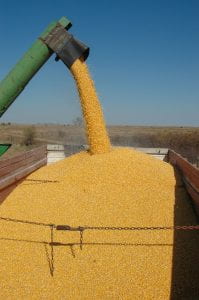by Jodi Putman
 Many combines used today for corn grain harvest are equipped with a yield monitoring system. Accurate evaluation of yields over several years, by field and by locations within fields, is important for the improvement of field management decisions over time. The best data is obtained when yield monitor equipment is properly calibrated, and yield data obtained is evaluated for errors. Without calibration, yield monitor results can be as much as 50% higher or lower than reality. Yield monitor systems consist of a moisture sensor, a mass flow sensor, a Global Positioning System (GPS), and a computer logger/display.
Many combines used today for corn grain harvest are equipped with a yield monitoring system. Accurate evaluation of yields over several years, by field and by locations within fields, is important for the improvement of field management decisions over time. The best data is obtained when yield monitor equipment is properly calibrated, and yield data obtained is evaluated for errors. Without calibration, yield monitor results can be as much as 50% higher or lower than reality. Yield monitor systems consist of a moisture sensor, a mass flow sensor, a Global Positioning System (GPS), and a computer logger/display.
The Yield Formula
As a combine is traveling, the yield monitor system records information on location, mass flow, and moisture content. A typical monitoring system is set to record data every second. By combining information on mass flow, logging interval, distance traveled during the logging interval, header width, grain test weight, and moisture content, as well as longitude and latitude, yield can be estimated according to this formula:
𝑌𝑖𝑒𝑙𝑑 (𝑏𝑢 𝑎𝑐) = (43,560) (𝑚∗𝑡 𝑑∗𝑤∗𝑝) (100−𝑀𝐶ℎ𝑎𝑟𝑣𝑒𝑠𝑡 100− 𝑀𝐶𝑚𝑎𝑟𝑘𝑒𝑡)
where:
- M = mass flow rate estimated from the impact sensor (pounds per second).
- T = logging interval of the yield monitoring system (seconds).
- D = distance traveled between logged location points (feet).
- W = header cut width setting (feet). · P = grain density or test weight (pounds per bushel).
- MCharvest = moisture content from yield monitor moisture sensor (percent).
- MCmarket = marketable moisture content (percent).
- 43,560= square feet per acre.
Equipment
- Moisture sensor
- Mass flow sensor
- Header position
- Lag time setting
- Global navigation satellite system or DGPS
- Header cut width setting
Calibration Steps
Calibration protocols include checking of settings and equipment prior to harvest as well as in-field checks during harvest.
Pre-Harvest Checks
- Header position. The position sensor should be placed in the correct location according to manufacturer standards.
- Lag time setting. An accurate lag time needs to be entered into the in-cab display to line up the mass flow sensor readings with the logged GPS points. This can be determined by counting the seconds from when the grain enters the head until it reaches the bin on the combine. Subtract two or three seconds Field Crops Extension 2 College of Agriculture and Life Sciences because the grain hits the mass flow sensor before it hits the bin. For most machines, the lag time is 10-15 seconds.
- Header cut width setting. This will need to be entered into the in-cab display. Most modern monitoring systems automatically adjust cut width after initial setup during times when less than a full cut-width (fewer rows) is harvested.
In-Field Tests
- Moisture sensor. Calibration steps as outlined by the machine manufacturer should be followed. The calibration can be checked by comparing the moisture sensor output with a grain moisture test at the local elevator or by using an oven to determine moisture content.
- Mass flow sensor. Perform calibrations frequently using the manufacturer’s standards. Re-calibration is needed every time a different crop is harvested and when moisture contents change significantly. Perform flow sensor calibration to capture the range of flow value (low, medium, and high) yield levels.
Best Management Practices
Use certified scale weights or a grain cart with load sensors to calibrate the yield monitor system. Grain carts outfitted with load sensors allow for frequent calibration. To avoid postharvest data confusion, prepare a boundary shape file that contains information about all farm fields (field name, area, crop to plant or planted, fertilizer/manure applied etc.), before harvest and upload this information to the monitor. Update field and crop labels upon entering each new field to harvest.
It is recommended to operate equipment within consistent calibrated speed ranges for each crop and to ensure the header is completely lifted at the end of each pass. This allows yield maps to show proper start and end passes and will reduce the amount of time needed for post-harvest data cleaning.
General Summary
Accurate yield data are essential for making better management decisions on the farm. Without calibration, yield monitors can produce inaccurate data. Check settings and frequently calibrate to ensure quality data.
Adapted from: http://nmsp.cals.cornell.edu/publications/factsheets/factsheet104.pdf

